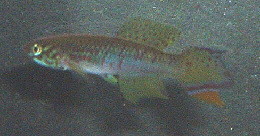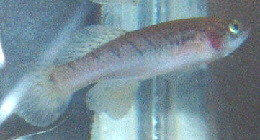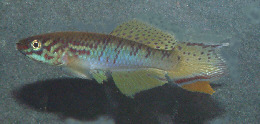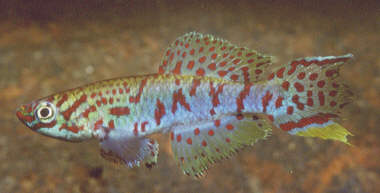Fundulopanchax robertsoni (Radda & Scheel 1974)
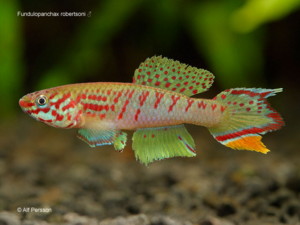


All above photos courtesy of Alf & Anita Persson, Sweden.
| Meaning of Name |
'After Mr. Robertson of the CDC rubber plantation in Ekona'. |
||||||
| First Description |
Radda A.C. & Scheel J.J. 1974. (Aphyosemion robertsoni). Aphyosemion puerzli nov. spec. und Aphyosemion robertsoni nov. spec., zwei neue Rivulinen aus Kamerun. Aquarium Journal 4 (3): p 37-41, figure 4-6. |
||||||
| Size |
5 cm |
||||||
| Meristics |
D = 16-18, A = 18, D/A = 3/1, ll = 27-29 +2-3 (Radda & Scheel 1974) |
||||||
| Karyotype |
n = 21, A = 39 (Radda & Scheel 1974) |
||||||
| Sub-Genus |
Paludopanchax |
||||||
| Group |
|
||||||
| Synonyms |
|
||||||
Populations
|
Wild male collected 1 km north
of Bolifamba, Cameroon (type locality). |
||||||
| Type Locality |
Collected in the CDC rubber plantation 1 km north of Bolifamba (5.6 km north of the Edea - Douala - Victoria road junction in the direction of Kumba), western Cameroon. |
||||||
| Distribution |
Presently only known from the type locality. |
||||||
| Habitat |
Dr.A.C.Radda collected them in a swampy area
in open bush inside the CDC Rubber Plantation at Ekona, situated around
1 km north of Bolifamba (5·6 km north of the crossing of the
Beau - Douala - Victoria roads in the direction of Kumba. This area
had an elevation of 300 m above sea level. 'A swampy area without an outlet in a depression on volcanic soil' (Wildekamp 1995) It would appear that the rubber plantation has been replaced with banana. Recent (2001/2) inspections of the type locality have failed to find any of this sp. although the time of this inspection was not given & may have been in the dry season. |
||||||
| Distinguishing Characteristics |
This sp. was seperated from it's close neighbour Fp.rubrolabialis on the grounds of marking differences & the type of biotope they were found in. Fp.rubrolabialis is found on sedimentary soils whereas Fp.robertsoni is found on volcanic ground. Fp.robertsoni is more heavily marked on body & fins. The anal fin in all photos I have seen has no red line (this may yet appear in future collections). The red line in Fp.rubrolabialis is placed mid way through the fin. |
||||||
| Colour/Pattern Variability | Low | ||||||
| History |
Collected by Dr.A.C.Radda on the 28th November 1973. Distributed by the BKA Species Control in November 1977. Known to have been in the Collingham auction in June 1978. |
||||||
| Breeding Notes |
Regarded as a difficult species to breed. Reports suggest using a peat substrate which can be taken out every few weeks & dried. Dry incubation takes about 4-6 weeks. On wetting, water of 16-18°C has been used succesfully. Fry are large enough to take newly hatched brine shrimp as a first food. Growth is quite rapid with sexual maturity being attained around 2 months.(Wildekamp 1995). Dr.A.C.Radda in BKA newsletter No.110, October 1974, considered them a bottom spawning sp. with a dry incubation of at least 3 months. Ed Pürzl experimented by wetting eggs after 70 days of dry storage but could not get fry to hatch. However, after 90 days of dry storage 30 fry hatched out. Latter wettings of this peat produced better results. Fred Wright wrote an article in BKA newsletter
No.129, May 1976 & did not regard them as easy. He advised water
of DH 1, pH 6·2, temperature 21-22°C. Richard Scoltock wrote a breeding report in BKA
newsletter No.159, November 1978. He put a reverse trio into a 12 x
8" tank with a bottom covering of Java moss. DH was 2, pH 6·8.
Frequent water changes were undertaken & seemingly enjoyed by the
fish. |
||||||
| Diameter of Egg | 0·9 mm. | ||||||
| Remarks |
|
